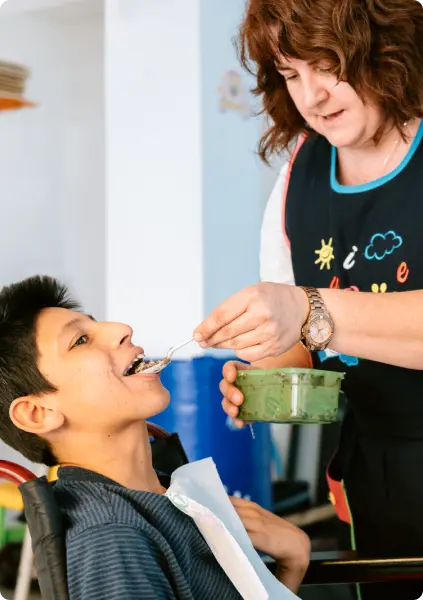Cerebral Palsy & Nutrition
Children with cerebral palsy (CP) have particular nutritional needs. Often, it’s difficult for them to consume enough calories to support normal growth. Vitamin and mineral deficiencies are also very common. In some patients, the use of supplements or dietary changes may be enough to address these issues. Patients who are unable to consume enough by mouth to meet their body’s needs may benefit from a procedure to allow tube feeding.
Home > What Is Cerebral Palsy? > Cerebral Palsy & Nutrition
- Last Updated Date: September 15, 2023
Children with cerebral palsy (CP) have unique nutritional needs. Each child’s needs will vary depending on the type and severity of their condition. CP affects a child’s ability to move, which can make it difficult for some kids to eat enough food to meet their needs for energy and certain nutrients. They may also have increased nutritional needs compared with other kids.
It’s important for parents and other caregivers to be aware of the importance of nutrition and pay attention to what their kids are eating. There are a few simple ways to help ensure that your child is getting enough of the right nutrients. For those with more severe challenges, there are interventions available that may improve your child’s nutritional status and ensure they’re getting everything they need.
Dietary Needs for Kids With Cerebral Palsy
CP can cause feeding problems and malnutrition for several reasons.
- Symptoms of cerebral palsy in children include low muscle tone, weakness in the muscles of the face, tongue, jaw, and throat. This can make it challenging for them to chew food, and it may be difficult for them to swallow safely.
- Because of coordination impairments, poor motor skills, and lack of strength in the arms and hands, children with CP may have feeding difficulties.
- Treatment for CP can lead to frequent hospitalizations, and kids with CP may develop infections more often than other kids. These issues increase their need for nutritional support.
- Kids with CP are more likely to have problems with digestion, like constipation or acid reflux (gastroesophageal reflux disease, or GERD). This can make it more uncomfortable for them to eat.
- Some medications used to help manage CP may have an impact on a child’s nutrition. For example, some pain medications can decrease a child’s appetite.
When children with CP struggle to consume enough calories to meet their energy needs, they may be underweight, and vitamin and mineral deficiencies can also occur.
Nutritional Support for Children with Cerebral Palsy
There are a few ways caregivers can support children with CP. It’s strongly recommended that a nutritionist, dietitian, or other medical professional monitor your child’s nutrition to ensure they’re getting everything they need. This may require testing your child’s levels of certain vitamins and minerals.
Supplements should only be given as directed by a medical professional because getting too much of some nutrients can actually be dangerous. For your child’s safety, it’s important that their care team is aware of everything that they’re getting. Don’t radically change your child’s eating plan or give them any new supplements without discussing it with their care team first.
Calories
Studies have shown that in children with motor disabilities like CP, half take in less than 80 percent of the calories they need. This lack of energy causes these children to be underweight and to grow slowly, and may make it harder for their bodies to heal from issues like infections.
In order for a child with CP to be as healthy as possible, they must get enough energy from food. This can sometimes be accomplished by putting extra effort into encouraging the child to eat and offering higher-calorie foods. Specially designed high-calorie nutritional shakes may be used in some kids to increase their caloric intake. For those who can’t take in enough food by mouth or who can’t swallow safely, tube feeding may be necessary.
Although it’s common for kids with CP to consume too little food, it’s also possible for them to consume too much and become overweight. Kids with limited mobility don’t use very many calories throughout the day, and it can be easy for their caregivers to overfeed them. Although it’s important that your child has enough energy from food, being overweight can also harm their health.
The usual methods of monitoring a child’s weight may not work as well in kids with CP. They have smaller muscles than other kids, so even if their body weight appears to be normal, they may actually have an unhealthy amount of fat tissue. Your child’s weight and body composition should be monitored on a regular basis, and if they start to gain too much weight, then their food intake may need to be reduced to keep them healthy.
Protecting Bones
The bones depend on weight-bearing exercise to get stronger, but because kids with any type of cerebral palsy have difficulty with movement, their bones often don’t receive the necessary strengthening exercises. CP patients may be at a higher risk of a fracture (a broken bone), especially if they aren’t able to walk. The risk of a fracture is particularly elevated in the bones of the spine, hips, legs, and upper arms.
Certain nutrients are important to keep bones strong and decrease the likelihood of a fracture. These include:
- Calcium
- Vitamin D
- Magnesium
- Phosphorus
Many kids with CP have a deficiency in some or all of these nutrients. For some, adding nutrient-rich foods to their diets will be adequate to raise their levels of these nutrients. However, supplements are often used to ensure that kids are getting enough of these important vitamins and minerals to protect their bones.
Other Vitamins and Minerals
Deficiencies of a variety of vitamins and minerals are common in children with CP. Besides the minerals listed above, many children also have low levels of other nutrients, including iron, niacin, folate, and vitamin E, even when taking supplements. Blood testing may be recommended to ensure that a CP patient is truly getting what their body needs.
Changes in Texture and Thickness
For children with CP who have trouble swallowing, it’s important to pay attention to the texture and thickness of what they’re eating. Foods may need to be softened, cut into very small bites, or pureed to make it easier for the child to eat them. For liquids, adding a thickener causes the liquid to move more slowly in the mouth, making it easier for the child to control it. This can make it less likely that the child will accidentally inhale the fluid rather than swallow it.
Your child’s treatment team can help you determine whether changing the texture and thickness of what your child eats and drinks may be helpful for them.
Feeding Interventions in Kids With CP
In general, for children with CP who are able to swallow well enough to eat safely, it’s recommended that the first line of treatment is to optimize the child’s diet. If this isn’t successful, other interventions, such as self-feeding with adaptive utensils, may be needed.
For CP patients who aren’t able to meet their dietary needs, enteral nutrition or oral nutritional supplements (ONS) may help. In children with extreme feeding problems or malnutrition, surgery may be necessary.
Changes in Texture and Thickness
This is a surgical procedure that creates an opening through the abdominal wall into the stomach. It can also be known as a G-tube, percutaneous endoscopic gastrostomy, PEG tube, or feeding tube.

In most cases, the tube is placed using an endoscope, which is a long flexible tube with a light and camera on the end. This is inserted down the throat into the stomach, and specially designed surgical instruments allow the surgeon to create an opening through the abdominal wall and place the PEG tube.
Formula, fluids, and medications can then be given through the tube directly into the stomach, bypassing the need for swallowing. This can help CP patients get enough calories and decreases the risk of choking. Studies have shown that gastrostomy can result in significant weight gain for underweight patients with CP. Because trying to eat can be very challenging for kids with CP, a gastrostomy may also have an emotional benefit, as it greatly reduces the stress of meal times. However, the procedure does carry some risk, and it’s not right for every patient.
A jejunostomy is a similar procedure, but the tube is placed into the small intestine rather than into the stomach. The absorption of food occurs in the small intestine, so giving formula through a jejunostomy also allows the child’s body to absorb the nutrients.
Nasogastric Tube
A nasogastric tube, or NG tube, is inserted through the nose and down the throat. The placement of an NG tube doesn’t require a surgical procedure; it can usually be done by a doctor or nurse while the patient is awake.
The placement of an NG tube carries a lower risk than a gastrostomy and doesn’t leave any permanent scars. However, it can be uncomfortable, and it’s difficult for many patients to tolerate it for very long. In addition, long-term use of an NG tube can cause sores inside the nose and increases the risk of stomach ulcers. Because of these issues, NG tubes are generally only used for the short term. Your child may receive an NG tube during a hospitalization, but if the intervention is working well and the decision is made to continue tube feeding for the long term, then a gastrostomy will generally be performed.
Surgery to Reduce Reflux
In children with significant acid reflux (heartburn), eating and drinking may be very uncomfortable. In addition, chronic reflux increases the risk of certain health problems, like damage to the esophagus and the teeth.
In some cases, a surgical procedure may be used to try to reduce the amount of acid reflux. This may improve the child’s nutrition by making it easier for them to eat enough healthy food.
A Nissen fundoplication is a procedure in which the top part of the stomach is wrapped around the esophagus to help prevent acidic stomach contents from passing upwards out of the stomach. In vertical gastric plication, staples are used to create a vertical division along part of the stomach at the point where the esophagus enters. This effectively lengthens the esophagus and makes it less likely that acidic stomach contents will make their way upwards out of the stomach.
In children with cerebral palsy, either of these procedures can reduce symptoms of acid reflux by about half. However, around 30 percent of children will experience a return of their reflux symptoms within a year. It’s important to carefully consider the risks and benefits of using a surgical procedure to treat reflux.
Written by:
Birth Injury Center Team
The Birth Injury Center aims to create informational web content and guides to help women and their families seeking support and guidance for birth injuries caused by medical negligence. All of the content published across The Birth Injury Center website has been thoroughly investigated and approved by medical expert Natalie Speer, RNC-OB, Attorney Ryan Mahoney.


